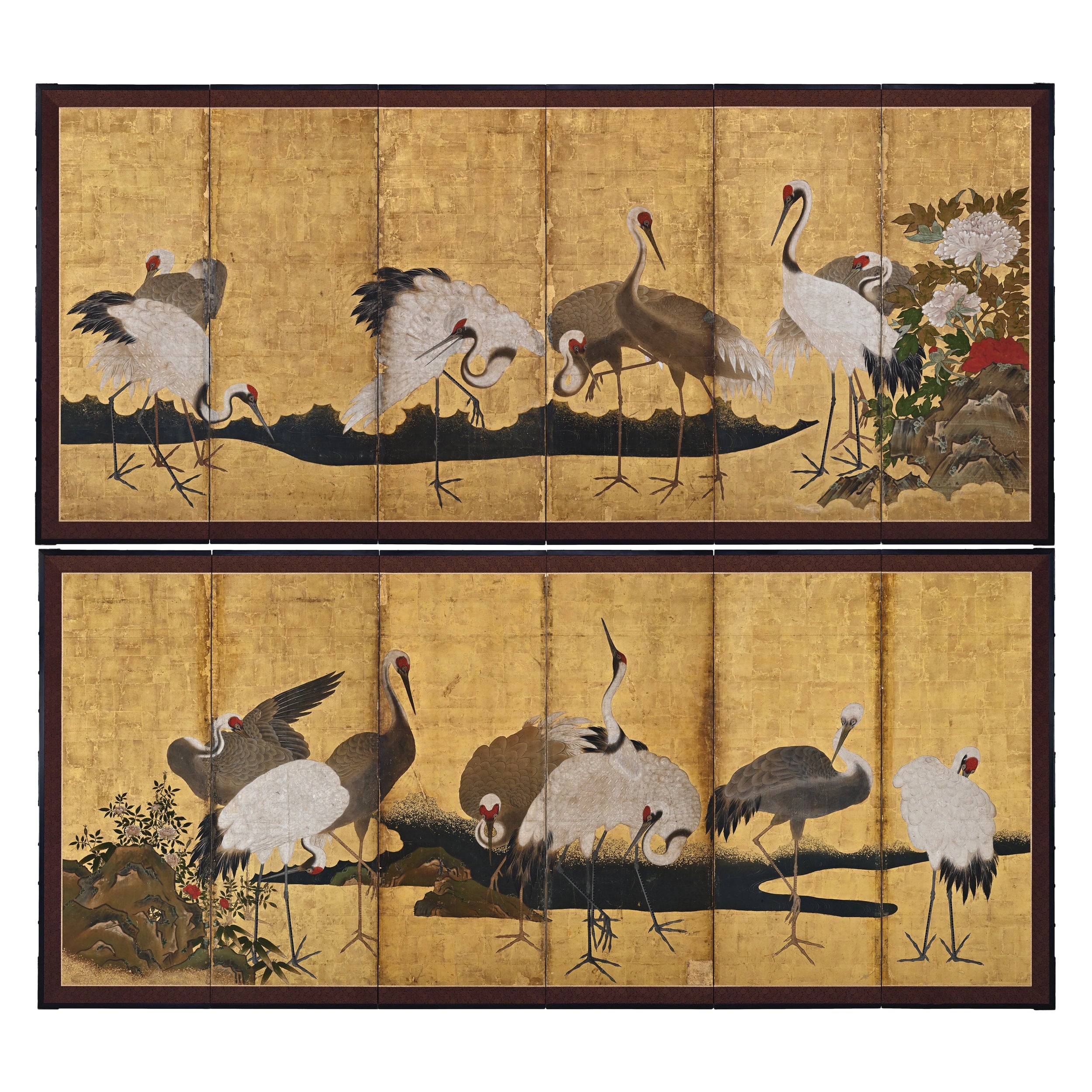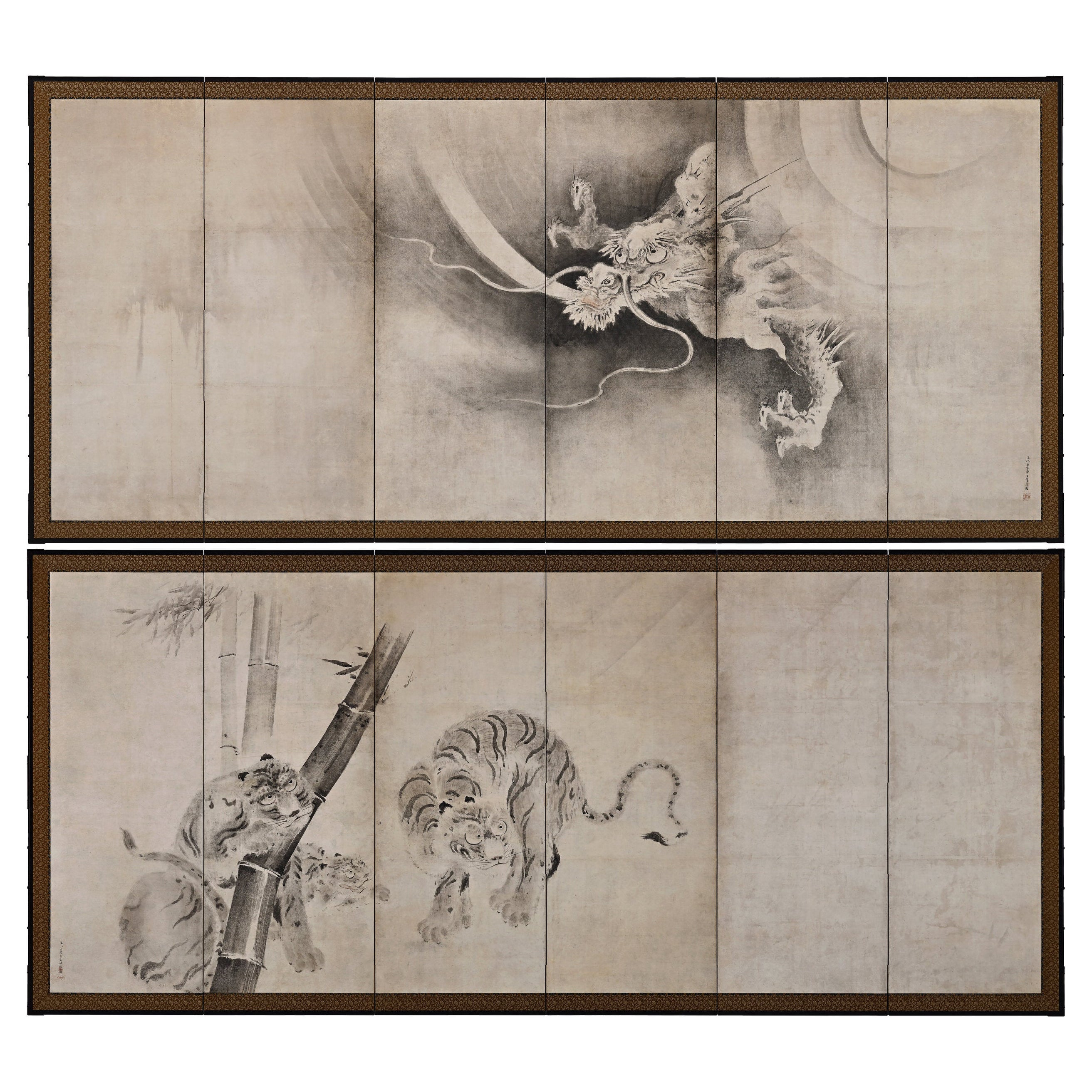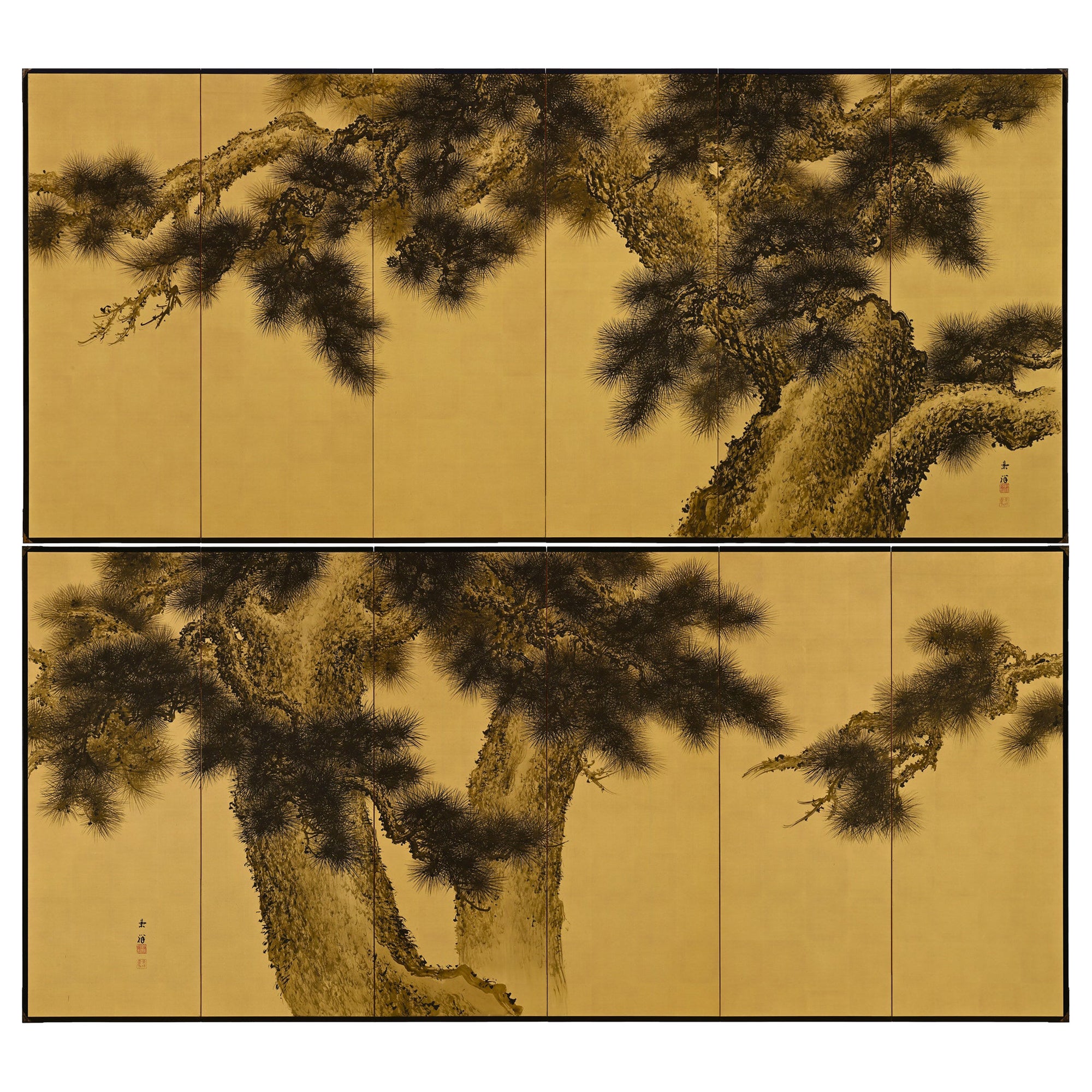Items Similar to 17th Century Japanese Screen Pair by Soga Nichokuan, Hawks on Pine & Plum Trees
Want more images or videos?
Request additional images or videos from the seller
1 of 13
17th Century Japanese Screen Pair by Soga Nichokuan, Hawks on Pine & Plum Trees
About the Item
Hawks on plum and pine
Soga Nichokuan (active circa 1625-1660)
Pair of six-fold screens.
Ink, mineral pigments, gofun, gold and speckled gold leaf on paper.
Upper seal: Hoin
Lower seal: Nichokuan
The combination of pine trees and hawks was a favourite subject of Japanese warrior-patrons from the 15th century on. Such representations painted on large screens or panels made impressive backdrops in main reception rooms. The painter of these screens, Soga Nichokuan, specialized in painting hawks, as did his father Soga Chokuan.
This pair of screens feature hawks on plum and pine trees, referencing winter and summer. They are painted on a paper ground which exhibits both gold wash and speckled gold leaf, which fills the pictorial surface and gives the effect of a bright and boundless atmosphere. The hawks have a dignified silhouette, their features carefully portrayed with jewel-like precision. The rock formations are textured with broad, parallel brush strokes. The clear, concise geometrical composition is counterbalanced with clusters of flowering camellias and hibiscus, which further emphasize the seasonal nature of the screens. The pine branches are characterized by their eccentric, knobbly forms. The plum tree is bent to form bold curves and its broken branches end abruptly with a broad sweep of the brush. This screen pair shares strong similarities with a pair of Nichokuan screens held at Kousanji (Kosan-ji) temple in Hiroshima prefecture and a pair of Nichokuan screens held at the Shimane Art Museum.
Each screen bears two seals reading Hoin and Nichokuan. Both of these seals are well-known. Soga Nichokuan was a highly respected and talented artist whose works are preserved in major temples throughout the Kansai region of Japan to this day. Nichokuan was succeeded by a number of painters, including Sanchokuan and Tamura Chokuou. Paintings by Soga Nichokuan are held at Daitoku-ji temple in Kyoto, Fumon-in in Wakayama, and Kosan-ji and Choen-ji in Hiroshima. Works by both Chokuan and Nicokuan are also preserved at a number of temples on Mount Koya in Wakayama. The pair of screens by Nichokuan held at Daitoku-ji temple is registered as an Important Cultural Property. In 1989, an important exhibition with an accompanying catalogue was held in Nara. It was dedicated to the screen and scroll paintings of Soga Chokuan and Nichokuan. Paintings of Soga Chokuan and Nichokuan; Elizabeth Ann Lillehoj, Nara Prefectural Museum of Art (1989).
- Dimensions:Height: 67.5 in (171.45 cm)Width: 148 in (375.92 cm)Depth: 0.75 in (1.91 cm)
- Sold As:Set of 2
- Style:Edo (Of the Period)
- Materials and Techniques:
- Place of Origin:
- Period:1640-1649
- Date of Manufacture:circa 1640
- Condition:Refinished. The screens have been completely remounted.
- Seller Location:Kyoto, JP
- Reference Number:1stDibs: LU2472320570842
About the Seller
5.0
Recognized Seller
These prestigious sellers are industry leaders and represent the highest echelon for item quality and design.
Established in 2001
1stDibs seller since 2016
60 sales on 1stDibs
Typical response time: 6 hours
- ShippingRetrieving quote...Ships From: Kyoto, Japan
- Return PolicyA return for this item may be initiated within 10 days of delivery.
More From This SellerView All
- 17th Century Japanese Screen. Ink Plum Tree & Birds by Kano Naonobu.Located in Kyoto, JPKano Naonobu (1607-1650) Plum Tree and Birds Six-fold Japanese Screen. Ink and slight color on paper. In this evocative ink work spread over a six-panel folding screen, we see the consummation of the elegance and refinement of the Edo Kano school. This 17th century screen is a rare surviving example of a large-scale bird and flower painting by Kano Naonobu, the younger brother of Kano Tanyu...Category
Antique 17th Century Japanese Edo Paintings and Screens
MaterialsWood, Paper
- 17th Century Japanese Screen Pair, CranesLocated in Kyoto, JPCranes Anonymous, Kano School. Edo period, second half of the 17th century. Pair of six-panel screens. Ink, pigment gofun and gold l...Category
Antique 1670s Japanese Edo Paintings and Screens
MaterialsGold Leaf
- 17th Century Japanese Screen Pair. Tiger & Dragon by Kaiho YusetsuLocated in Kyoto, JPKaiho Yusetsu (1598-1677) Tiger and Dragon Early Edo Period, Circa 1650 A Pair of Six-fold Japanese Screens. Ink and slight color on paper. Dimensions: Each screen: H. 171 cm x W. 380 cm (67.5’’ x 149.5’’) In this pair of early Edo period Japanese screens a group of tigers prowl in a bamboo grove whipped with fierce wind, while a dragon claws through clouds and mist. The dragon embodies elemental qualities - looming out of the mist, the coils of its body disappearing in the clouds. The dragon is calling for rain, symbolizing spring which is considered the fountain of life. On the other side, the tigers calls for the wind, symbolizing autumn which is considered the end of life. Tigers were familiar motifs within Japanese art from ancient times though the animals were imaginary to the people in the 17th century. While dragons and tigers are usually associated as sacred and ferocious, in this painting, both animals have rather amusing expressions. The tigers appear to glare at the dragon with cat-like eyes, and the look on the swirling dragon’s face appears almost affectionate - lending a playful flair to an otherwise magnificent theme. The tiger and dragon are cosmological symbols of the balancing forces in the world. Screens such as this were originally meant to express the fluctuating nature of the world. For Japanese in the early Edo period, they likely suggested the powers of the cosmos. In Japan the tiger and dragon motif was originally absorbed into the circles of Zen monasteries before spreading into the secular world. The theme especially appealed to the military classes with the Kano school, the official painters to the Shogun and the samurai, being the leading contributors. The painter of this pair of screens, Kaiho Yusetsu (1598-1677), was closely patronized by the third Shogun Tokugawa Iemitsu. In his later years he worked with Kano school artists...Category
Antique Mid-17th Century Japanese Edo Paintings and Screens
MaterialsSilk, Wood, Paper
- 19th Century Small Japanese Screen Pair, Pine Trees and Vines on Gold LeafLocated in Kyoto, JPThis pair of screens depict just the middle sections of aged pine trees, painted in bold brush strokes on a background of gold leaf clouds. The trees are draped in vines, the lush cr...Category
Antique Mid-19th Century Japanese Edo Paintings and Screens
MaterialsGold Leaf
- 17th Century Japanese Framed Painting by Kano Sansetsu, Plum Blossoms in SnowLocated in Kyoto, JPKano Sansetsu (1589-1651) Plum blossoms in snow Edo period, circa 1640 Framed painting. Ink on paper. Kano Sansetsu is a Japanese painter who...Category
Antique 17th Century Japanese Edo Paintings and Screens
MaterialsPaper
- Early 20th Century Japanese Screen Pair - Ink Pine Trees on GoldLocated in Kyoto, JPImao Keisho (1902-1993) Pine Trees Early 20th Century, Circa 1930 Pair of six-panel Japanese screens. Ink on silk and gold leaf. Dimensions: Each screen H. 67.5” x 148” (172 cm x 376 cm) A pair of monumental six-panel Japanese pine screens by the renowned Nihonga artist Imao Keisho. Here Keisho entirely removed the background and brought the pine trees to the surface of the painting. This simplification of the elements makes the scene exceptionally direct and compelling and injects a very modern...Category
Early 20th Century Japanese Showa Paintings and Screens
MaterialsGold Leaf
You May Also Like
- 17th Century Japanese Two-Panel Screen, Gibbons of FolkloreLocated in Hudson, NYJapanese two-panel screen: Gibbons of Folklore, Edo period (17th century) Kano School painting of gibbons in Japanese fables. The left panel represents a Japanese fable of a monkey a...Category
Antique Late 17th Century Japanese Edo Paintings and Screens
MaterialsSilk, Wood, Paper
- Late 17th-Early 18th Century Japanese Six-Panel Screen, Battle at Uji BridgeLocated in Hudson, NYJapanese six-panel screen: Battle at Uji Bridge, the first battle at Uji was in 1180 and it marked the start of the Heike Wars. The Genji troops crossed the...Category
Antique Late 17th Century Japanese Edo Paintings and Screens
MaterialsGold Leaf
- Six Panel Japanese Screen: Winter Scene of Pine, Plum, and BambooLocated in Hudson, NYJapanese Six Panel Screen: Winter Scene of Pine, Plum, and Bamboo Under Crescent Moon. Pine, plum and bamboo are known as the three friends of winter, because they all thrive and bl...Category
Early 20th Century Japanese Taisho Paintings and Screens
MaterialsPaper, Wood
- Japanese Two-Panel Screen Ink Painting of Palm Trees on PaperLocated in Hudson, NYJapanese two-panel screen: ink painting of Palm Trees on paper, Edo period (1787) beautiful painting of Japanese windmill palm trees. Ink paint...Category
Antique 18th Century Japanese Edo Paintings and Screens
MaterialsPaper, Silk, Wood
- Japanese Two Panel Screen Winter Flowering Plum on Gold LeafLocated in Hudson, NYMineral pigment on gold leaf.Category
Antique 19th Century Japanese Paintings and Screens
MaterialsGold Leaf
- 18th Century Japanese Two-Panel Screen Collection of Fans on GoldLocated in Hudson, NY18th century Japanese Screen of a Collection of Fans. Paintings on fans depict famous Japanese painting subjects, this screen was most li...Category
Antique 18th Century Japanese Edo Paintings and Screens
MaterialsGold Leaf
Recently Viewed
View AllMore Ways To Browse
Screen With Trees
Large Screen Panel
Six Fold
Gold And Plum
Pines Japanese
Large Asian Screen
Painting Of Woods And Trees
Japanese Screens Large
Paper Folding Screen
Papered Folding Screen
Painting Antique Pine Furniture
Japanese Brushes
Japanese Brush
Plum Tree
15th Century Japan
15th Century Japanese
Asian Painting On Gold Leaf
Painting With Gold Pair





